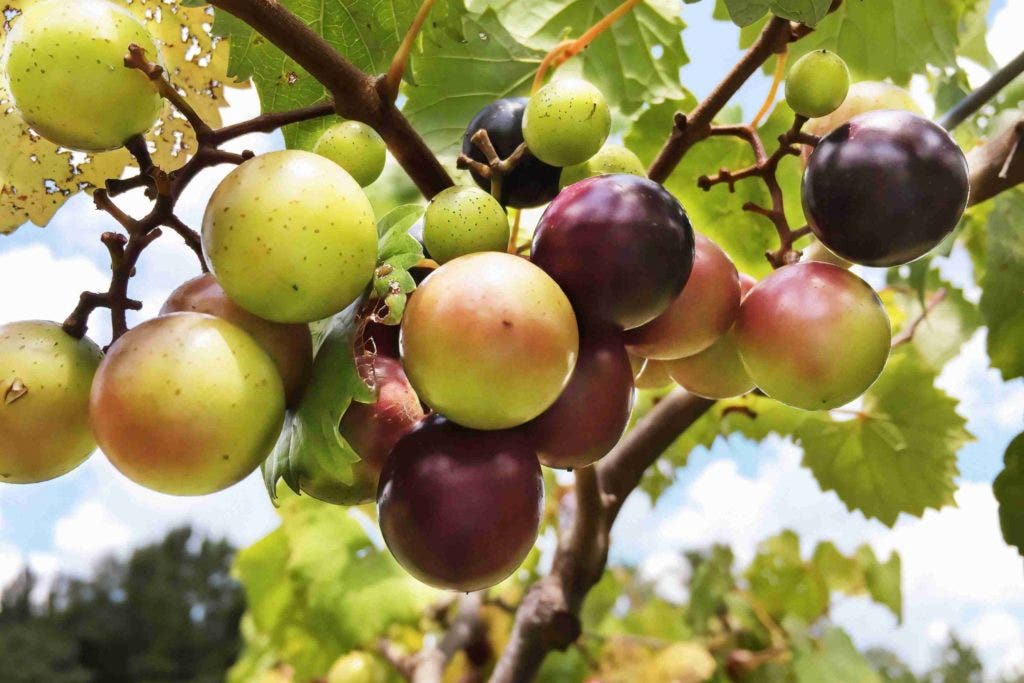Muscadine wine can be divisive. Acolytes praise its accessible flavors, ecological sustainability and historical significance, while detractors call it one-dimensional.
“There’s this stigma that they’re all sweet,” says Elizabeth Higley, assistant winemaker at Windsor Run Cellars in North Carolina. “But I’ve had some dry, traditional method sparkling Muscadine wines, and they’re incredible. They can be just as elegant as any vinifera wine we make here.”
Vitis vinifera like Chardonnay and Pinot Noir hail from Europe and comprise the majority of wine grapes growing in the United States. Muscadine wine is Vitis rotundifolia and native to the southeastern United States, where professionals like Higley believe it’s ripe for a national renaissance.
So, what is Muscadine wine? Can it change to suit modern tastes? And do enough people want it to?
What is Muscadine Wine?

Muscadine wine can be red, white or rosé, and be either made still or sparkling. It can be vinified sweet, off-dry or dry.
There are more than 100 types of Muscadine grapes grown in the United States, although only a handful are used for winemaking. The grapes are thick-skinned, antioxidant-rich and range from green to black in hue. They thrive in heat and humidity, and they resist many vineyard diseases and pests, including phylloxera. Common Muscadine cultivars in the southeastern U.S. include Carlos, which is used primarily for white winemaking, and Scuppernong, which is eaten out of hand and named for North Carolina’s Scuppernong River.
Sometimes, American-born Muscadine is mistaken for the similarly named Mediterranean variety Muscat, but they’re not related. “Two different grapes, two different cultural heritages and origin stories,” says Robin Caldwell, a food history researcher and writer.
The History of Muscadine Wine
Muscadine is believed to have been the first native grape cultivated in North America. As proof, researchers point to the Mother Vine, a Scuppernong plant on North Carolina’s Roanoke Island. Estimated to be at least 400 years old, the Mother Vine may have been cultivated by Croatans prior to European colonists’ arrival in 1587.
“It was both a source of libation and income before America was America,” says Caldwell of Muscadine wine. “I believe Muscadine wine deserves respect.”
As colonization progressed and the United States formed, it proved profitable. According to the North Carolina Muscadine Grape Association, in 1840 the state was the top wine producer in the U.S., “with an industry built entirely on Muscadine grapes.”
Caldwell notes that Muscadine grapes were vital to enslaved laborers throughout the antebellum South. “Muscadine was foraged food. Access was easy, especially for enslaved Africans with the ability to enter into the woods or who lived near the woods with vines. It was used for medicinal purposes, food and wine.”
Following emancipation and through the 20th century, Muscadine grapes and wine remained economically and culturally significant.
The fruit was foraged and cultivated, and “provided a decent stream of income for Black American farmers in states like North Carolina, South Carolina, Georgia, Tennessee, Virginia and Florida,” says Caldwell.
Modern Muscadine

Local, sustainable and with a powerful story, Muscadine wine checks a lot of boxes for modern consumers. The challenge, wine professionals say, is getting more people to try it.
“I haven’t tasted it in years, but I remember it being very sweet,” says Charles W. Hunter III, a personal chef and recipe developer in Nashville, TN, who celebrates the arrival of the sweet fruit each season. He’s interested to taste drier expressions of Muscadine wine, however. “You pop the grapes in your mouth and it’s just a rush of sweetness. It would be interesting to see what that looks like tamped back a bit in wine.”
Higley has seen Muscadine converts in tasting rooms. “We’ve noticed that if you pour a dry one for people, they change their mind pretty quickly,” she says, describing dry Muscadine wine as “low-ABV, crisp, dry, porch pounders.”
Where to find them? Overmountain Vineyards and Cypress Bend, both in North Carolina, produce dry Muscadine wines. Windsor Run Cellars is currently experimenting with carbonic maceration Muscadine. In Kathleen, GA, Tilford Winery produces an array of dry, semi-sweet and sweet Muscadines, all of which are organic.
Perhaps we’ll be seeing more of this style in the future, too. Hardy Muscadine is suited to low-intervention winemaking, especially as the climate warms.
“We grow a lot of vinifera here but it’s incredibly challenging, you have to spray a lot and manipulate to make quality wine,” she says. “Muscadine grapes are supposed to be here, they like growing here, and they’re going to be here for a very long time. It’s about time we start giving them the respect they deserve.”
Last Updated: August 21, 2023















